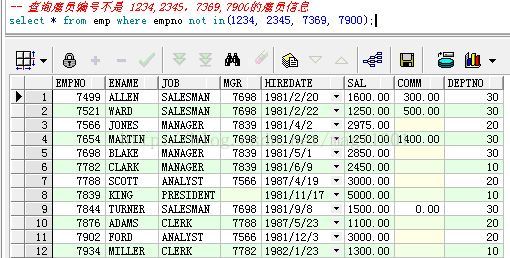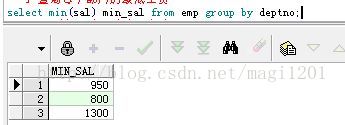oracle子查询
Posted
tags:
篇首语:本文由小常识网(cha138.com)小编为大家整理,主要介绍了oracle子查询相关的知识,希望对你有一定的参考价值。
子查询:在一个查询的内部包含另外一个查询。
普通子查询
-- 查询出比7654工资还高的所有雇员的信息 select * from emp e where e.sal > (select sal from emp where empno = 7654); -- 查询出工资比7654高,同一时候与7788从事同样工作的所有雇员的信息 select * from emp e where e.sal > (select sal from emp where empno = 7654) and e.job = (select job from emp where empno = 7788); -- 查询出工资最低的雇员姓名、工作、工资 select e.ename, e.job, e.sal from emp e where e.sal = (select min(sal) from emp);
in 查询
in keyword用来匹配一个集合中的记录
-- 查询雇员编号为1234,2345,7369,7900的雇员信息 select * from emp where empno in(1234, 2345, 7369, 7900);

-- 查询雇员编号不是 1234,2345。7369,7900的雇员信息 select * from emp where empno not in(1234, 2345, 7369, 7900);

-- 查询每一个部门的最低工资相应的员工信息 select * from emp where sal in (select min(sal) from emp group by deptno);

anykeyword
any:表示随意的。
< any
比子查询返回的随意一个结果小就可以,即小于返回结果的最大值
= any
和子查询中随意一个结果相等就可以。相当于in
> any 比子查询返回的随意一个结果大就可以,即大于返回结果的最小值
-- 查询每一个部门的最低工资 select min(sal) min_sal from emp group by deptno;

sal 大于 any (每一个部门最低工资),即大于返回结果的最小值
select * from emp where sal > any (select min(sal) from emp group by deptno);

sal = any (每一个部门最低工资),即 和子查询中每一个结果相等,同in
select * from emp where sal = any (select min(sal) from emp group by deptno);

sal < any (每一个部门最低工资)。即大于返回结果的最大值
select * from emp where sal < any (select min(sal) from emp group by deptno);

allkeyword
all:表示全部的。
< all
比子查询返回的全部的结果都小,即小于返回结果的最小值
> all
比子查询返回的全部的结果都大,即大于返回结果的最大值
= all
无意义。逻辑上也不成立
查询工资在2000 到 3500的工资段的工资集合
select distinct sal from emp where sal between 2000 and 3500;

> all (工资在2000 到 3500的工资段的工资集合) ,即大于最大值
select * from emp where sal > all(select distinct sal from emp where sal between 2000 and 3500);

< all (工资在2000 到 3500的工资段的工资集合),即小于最小值
select * from emp where sal < all(select distinct sal from emp where sal between 2000 and 3500);

以上是关于oracle子查询的主要内容,如果未能解决你的问题,请参考以下文章